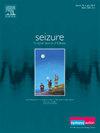Functional imaging in late-onset epilepsy: A focused review
IF 2.7
3区 医学
Q2 CLINICAL NEUROLOGY
引用次数: 0
Abstract
Introduction
About 25 % of new-onset epilepsies are diagnosed after age 65. Late-onset epilepsy (LOE) is predicted to become a major healthcare problem in the next 15 years as the global population increases and ages. Neurodegenerative disorders account for 10–20 % of LOE, while over 20 % of these patients have an unknown etiology. Established diagnostic tools such as FDG-PET and novel biomarkers of neurodegeneration including amyloid and tau PET hold a lot of promise in diagnosing and ruling out neurodegenerative disorders in these patients.
Methods
We conducted a literature search to identify articles involving LOE populations and using one or more functional neuroimaging techniques.
Results
A total of 5 studies were identified through Boolean searching and snowballing. These were highly heterogenous with respect to operational definitions of LOE, analyses and interpretation pipelines.
Conclusion
While there is some evidence for feasibility and usefulness of FDG- and Amyloid PET in LOE, methodological heterogeneities in the available literature preclude any notable conclusions. Future research in this field will benefit from a consensus on epilepsy-specific analysis and interpretation guidelines for amyloid and tau PET.
晚发性癫痫的功能成像:重点回顾。
导言:大约 25% 的新发癫痫是在 65 岁以后确诊的。随着全球人口的增长和老龄化,晚发性癫痫(Late-onset epilepsy,LOE)预计将在未来 15 年内成为一个主要的医疗保健问题。神经退行性疾病占晚发癫痫的 10-20%,而其中超过 20% 的患者病因不明。FDG-PET等成熟的诊断工具和包括淀粉样蛋白和tau PET在内的新型神经变性生物标记物在诊断和排除这些患者的神经变性疾病方面大有可为:我们进行了文献检索,以确定涉及 LOE 群体并使用一种或多种功能神经成像技术的文章:结果:通过布尔搜索和 "滚雪球 "法,我们共发现了5项研究。这些研究在LOE的操作定义、分析和解释管道方面存在很大差异:虽然有一些证据表明 FDG 和淀粉样蛋白 PET 在 LOE 中的可行性和实用性,但现有文献中方法的不一致性排除了得出任何显著结论的可能性。就淀粉样蛋白和 tau PET 的癫痫特异性分析和解释指南达成共识将有利于该领域未来的研究。
本文章由计算机程序翻译,如有差异,请以英文原文为准。
求助全文
约1分钟内获得全文
求助全文
来源期刊

Seizure-European Journal of Epilepsy
医学-临床神经学
CiteScore
5.60
自引率
6.70%
发文量
231
审稿时长
34 days
期刊介绍:
Seizure - European Journal of Epilepsy is an international journal owned by Epilepsy Action (the largest member led epilepsy organisation in the UK). It provides a forum for papers on all topics related to epilepsy and seizure disorders.
 求助内容:
求助内容: 应助结果提醒方式:
应助结果提醒方式:


